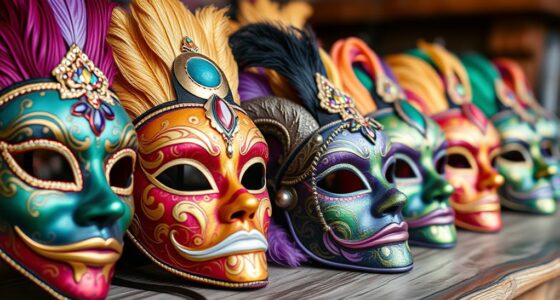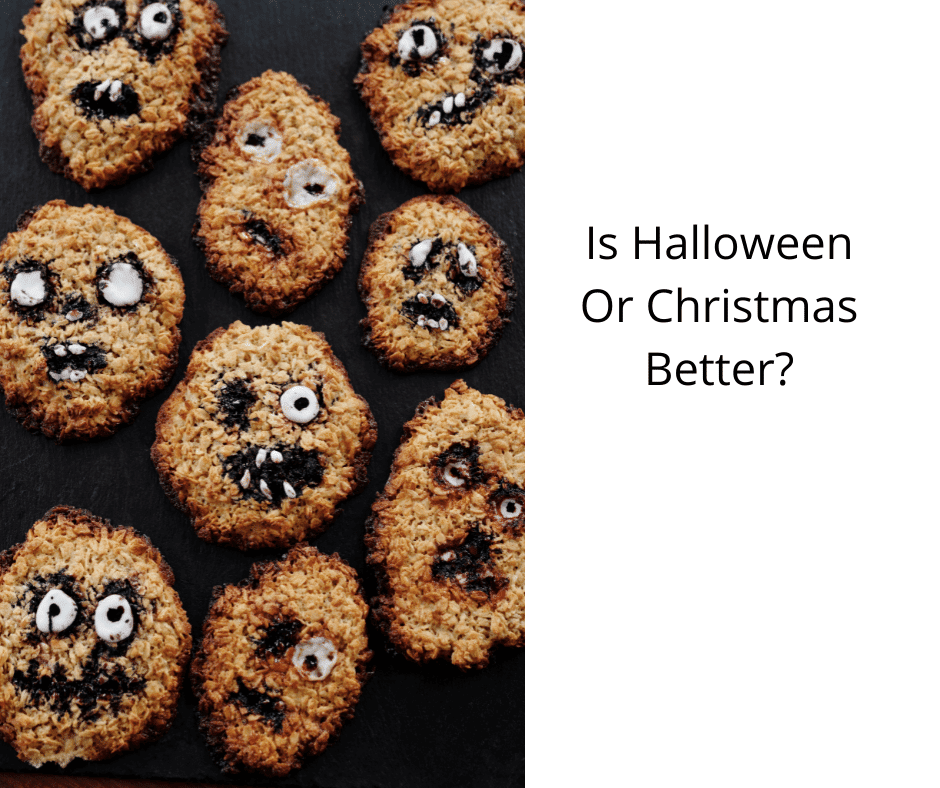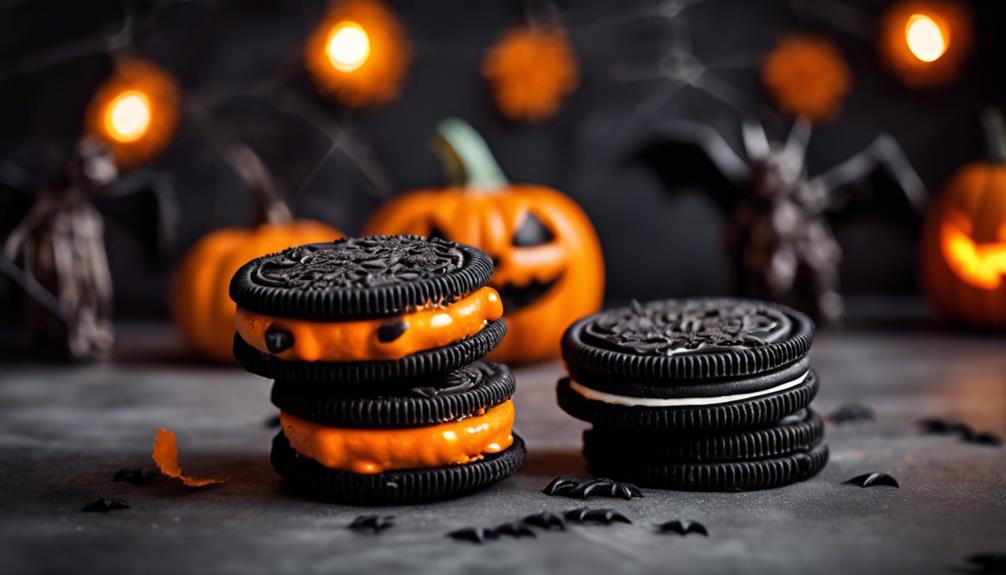Halloween traditions span the globe, each offering a unique spin on celebrating this spooky season. In Mexico, you've got Día de los Muertos, where families honor deceased loved ones with vibrant altars. In Ireland and Scotland, Samhain marks the change to winter with bonfires and feasts. Japan embraces Halloween trains, adding a festive atmosphere with creative costumes. Italy's Ognissanti focuses on honoring saints, while Guatemala's Festival de Barriletes Gigantes showcases giant kites to connect the living with the dead. Each tradition reflects the culture, and if you explore more, you'll uncover fascinating stories behind these customs.
Key Takeaways
- Día de los Muertos in Mexico celebrates deceased loved ones with altars, food, and vibrant decorations from October 31 to November 2.
- Samhain in Ireland and Scotland marks the transition to winter with bonfires, feasts, and a belief in the blurred boundaries between the living and the dead.
- Festival De Barriletes Gigantes in Guatemala features giant handmade kites symbolizing a connection between the living and the deceased during All Saints Day.
- Pangangaluluwa in the Philippines involves children singing and collecting treats while honoring the spirits of the departed, blending pre-colonial and Catholic customs.
- Hungry Ghost Festival in China honors ancestors with food offerings and traditional dances to appease spirits during the seventh lunar month.
Día De Los Muertos – Mexico
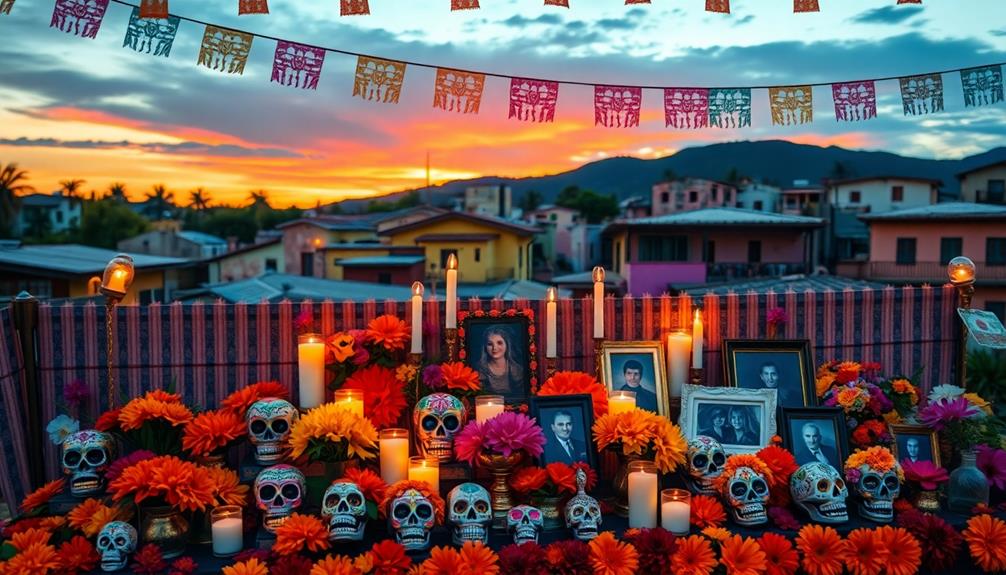
Día de los Muertos, or Day of the Dead, brings to life the rich traditions of Mexico from October 31 to November 2. During this vibrant celebration, you honor your deceased loved ones by creating altars, or ofrendas. These altars are filled with their favorite foods, drinks, and personal items, welcoming their spirits back into the living world.
As you prepare for the festivities, you'll notice colorful decorations featuring marigolds (cempasuchil), candles, and intricately designed sugar skulls. Each element plays a significant role in inviting the spirits to join in the celebration, blending indigenous customs with Catholic practices. Unlike typical mourning rituals, Día de los Muertos focuses on joy and remembrance.
Gatherings often take place in cemeteries, where families spend time with their deceased loved ones, sharing meals and recounting cherished stories. You'll feel a deep sense of community and connection as everyone comes together to celebrate life and death.
This holiday has gained international recognition, with UNESCO designating Día de los Muertos as an Intangible Cultural Heritage of Humanity, showcasing its cultural significance and the unique traditions that make it so special.
Samhain – Ireland and Scotland
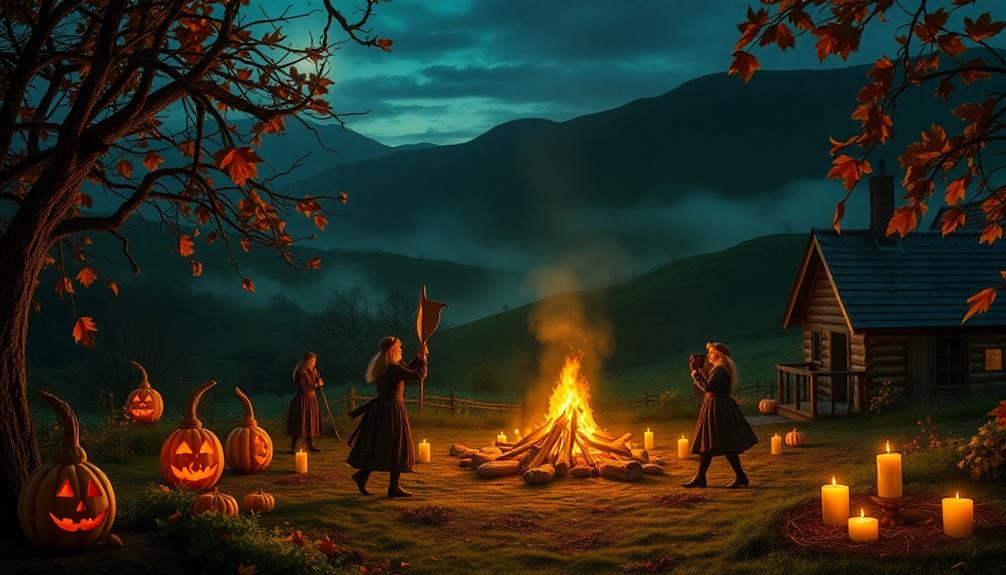
Samhain, a Gaelic festival celebrated from October 31 to November 1, marks the shift from the harvest season to the cold depths of winter. This ancient tradition, rooted deeply in Irish and Scottish culture, is believed to dissolve the boundary between the living and the dead. During this time, you might find spirits mingling among the living, creating a mystical atmosphere.
Historically, people lit bonfires to ward off evil spirits and held feasts to honor their deceased loved ones. These practices laid the groundwork for many modern Halloween traditions from around the world, including costume-wearing and trick-or-treating. As you participate in these festive activities today, you're connecting with centuries of cultural significance.
Samhain was first documented in 9th-century Irish literature, showcasing its long-standing place in Celtic heritage. It's fascinating to realize that the very essence of what you celebrate during Halloween can be traced back to this vibrant festival.
Halloween Trains – Japan
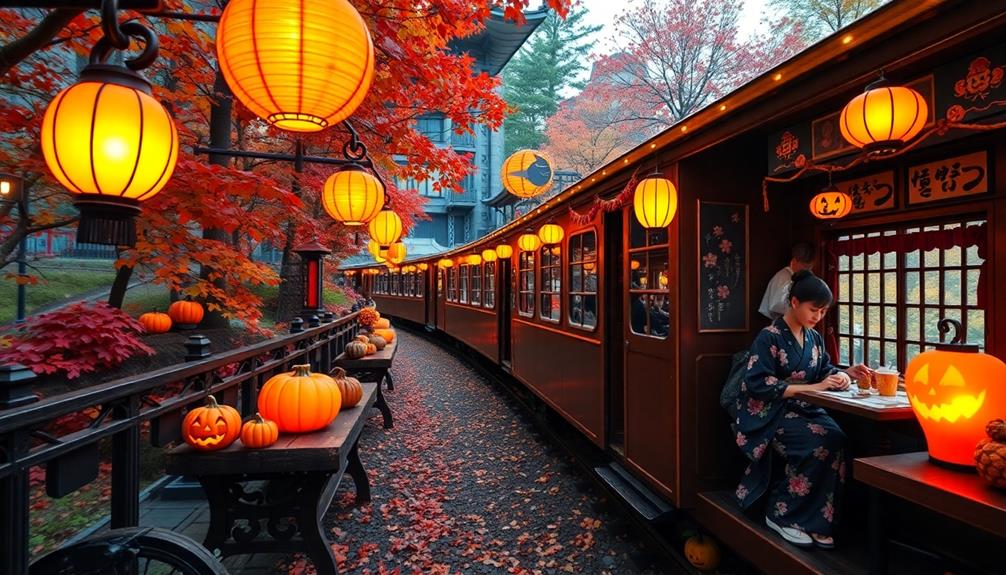
When you hop on a train in Japan during Halloween, you're in for a spooky treat.
These themed train experiences come alive with decorations and passengers dressed as zombies and vampires, creating a festive atmosphere for everyone on board.
It's a unique way to celebrate the season while commuting through the city!
Themed Train Experiences
If you find yourself in Japan during Halloween, you might want to hop on one of the themed trains that have become a unique part of the celebration. Starting in 2000, with Tokyo Disneyland's first Halloween event, these trains have transformed the way people enjoy Halloween celebrations. Instead of traditional trick-or-treating, the focus here is on elaborate costume displays and vibrant street parties.
When you board one of these spooky trains, you'll be surrounded by decorations that create an eerie atmosphere, reminiscent of haunted houses. These experiences offer a chance to mingle with fellow passengers dressed in their finest costumes, making it feel like a traveling costume party.
Major cities like Tokyo and Osaka host spectacular Halloween parades, where you can see some of the most creative costumes while traveling to your next destination.
As Halloween has evolved into a massive commercial event, shopping centers and theme parks promote activities that enhance the festive spirit. Riding a themed train during this time not only provides a unique experience but also immerses you in the lively culture of Halloween in Japan.
Don't miss out on this unforgettable ride!
Zombie and Vampire Costumes
Dressing up in zombie and vampire costumes has become a thrilling highlight of Halloween trains in Japan, where the spooky spirit comes alive. These themed trains transport you into a world of horror, with passengers adorned in elaborate Halloween costumes that reflect the influence of pop culture. Since the first Halloween event at Tokyo Disneyland in 2000, Japan's Halloween celebrations have grown exponentially, turning into a vibrant commercial phenomenon.
As you ride these Halloween trains, you'll encounter immersive experiences, complete with actors dressed as zombies and vampires. Street parties and parades further amplify the excitement, showcasing creative costume displays that inspire everyone to join in the fun. Here's a quick look at some popular costume ideas for this Halloween season:
| Zombie Costumes | Vampire Costumes | Tips for Success |
|---|---|---|
| Classic zombie makeup | Traditional vampire attire | Use fake blood |
| Undead schoolgirl | Gothic elegance | Accessorize wisely |
| Zombie pirate | Modern vampire chic | Practice your poses |
| Decaying bride | Vampire hunter | Get comfortable in costume |
| Zombie animal | Historical vampire | Bring a friend for fun |
Join in the festivities and embrace the haunting allure of Halloween!
Ognissanti – Italy
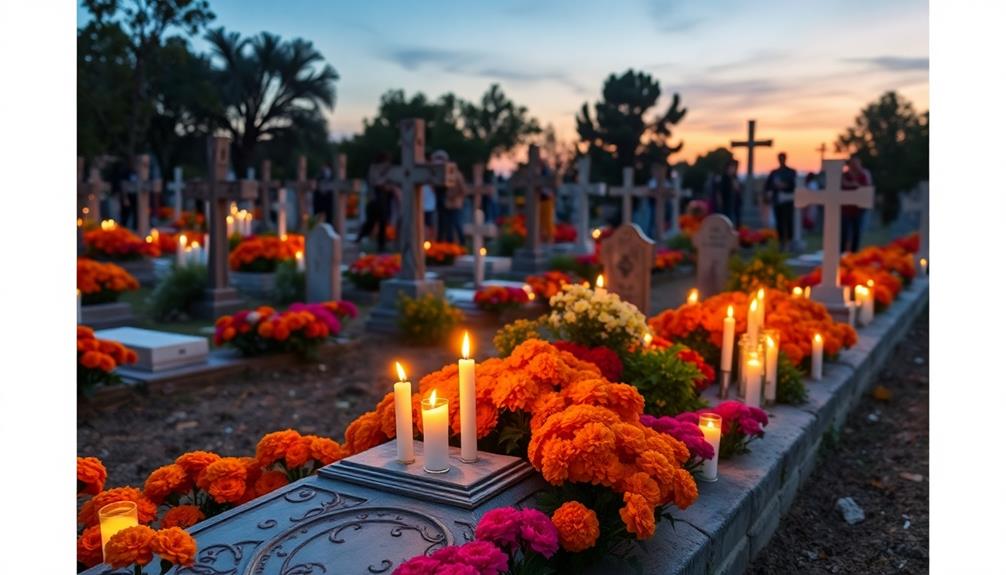
In Italy, Ognissanti, or All Saints' Day, is a time for honoring saints and remembering loved ones who've passed.
You'll find families gathering for special meals and offering gifts at gravesites, with unique traditions varying by region.
From sweet treats for children in Sicily to placing chrysanthemums on graves, every celebration carries its own significance.
All Saints' Day Rituals
Every year on November 1st, Italians come together to celebrate Ognissanti, or All Saints' Day, honoring the saints and martyrs of the Catholic Church. This day is deeply rooted in family traditions, where you might find families preparing special meals to remember their deceased loved ones.
In Rome, visiting gravesites becomes a meaningful ritual, as relatives pay their respects and decorate the resting places with flowers.
Regional variations add unique flavors to the observance. For instance, in Sicily, children often receive gifts from their deceased relatives, creating a link between the living and the departed.
Meanwhile, in Sardinia, it's common to go door-to-door, sharing offerings with neighbors and fostering a sense of community.
In the Abruzzo and Trentino regions, you'll see lanterns made from pumpkins, blending the Halloween spirit with traditional Italian practices.
These lanterns illuminate the night, guiding spirits home and adding a festive touch to the somber occasion. Ognissanti is a time of reflection, connection, and honoring the bonds that transcend life and death, reminding you of the importance of family and community during this sacred time.
Traditional Foods and Offerings
During Ognissanti, traditional foods play a vital role in honoring the deceased and bringing families together. One of the most beloved treats is frittelle, a delicious doughnut often enjoyed during this time.
In Sicily, children enthusiastically anticipate receiving sweets and pastries as gifts from their deceased relatives, which deepens the connection between the living and the dead through the act of sharing food. Additionally, these treats can be a source of comfort and energy, much like the health benefits of honey that can enhance energy levels and reduce fatigue.
In Rome, families gather near gravesites to honor their loved ones with special meals that typically include roasted meats and seasonal vegetables. This practice emphasizes the importance of remembering those who've passed while enjoying a meal together.
Another popular custom is the preparation of fave dei morti, almond cookies shaped like skulls. These cookies serve as a poignant symbol of remembrance for the deceased.
You'll also find festive lanterns made from pumpkins in regions like Abruzzo and Trentino, adding a vibrant touch to the culinary traditions of Ognissanti.
These traditional foods not only nourish the body but also nourish the spirit, creating a meaningful bond that transcends generations.
Regional Celebration Variations
Ognissanti, celebrated across Italy on November 1, showcases a rich tapestry of regional variations that highlight local customs and traditions.
In Sicily, for instance, children enthusiastically receive sweets from the deceased, creating a unique connection between the living and the departed. Meanwhile, in Sardinia, kids go door-to-door, asking for offerings, reminiscent of the practices seen during Halloween.
In Rome, families gather for special meals near the gravesites of their loved ones, honoring their memory in a deeply personal way. This communal aspect emphasizes the importance of remembrance, akin to the Day of the Dead celebrated in Mexico, where families also honor their ancestors.
You might notice that in regions like Abruzzo and Trentino, lanterns carved from pumpkins light the night, blending traditional Halloween motifs with local culture.
These variations enrich the celebration, making it a unique experience that combines both solemn remembrance and festive spirit. Whether it's through the sharing of sweets or gathering around graves, Ognissanti serves as a heartfelt reminder of familial connections, showcasing Italy's diverse ways of celebrating life and death.
Festival De Barriletes Gigantes – Guatemala
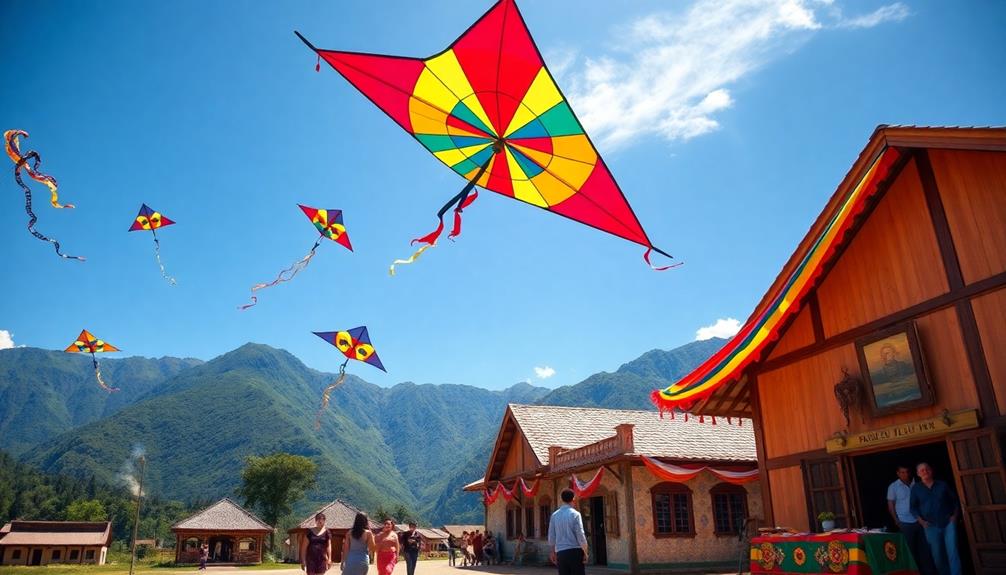
In Guatemala, the Festival de Barriletes Gigantes brings vibrant colors and joyous spirits to the celebration of All Saints Day and the Day of the Dead. Held at the beginning of November, this festival features giant handmade kites that can soar up to 40 feet in length. Families gather in towns like Santiago Sacatepéquez and Sumpango, where children and adults alike participate in crafting these magnificent kites from colorful paper, cloth patches, and bamboo.
Each kite symbolizes a bridge connecting the living with their deceased loved ones, allowing for a unique form of communication with spirits. The kite-flying tradition, which spans over 3,000 years, showcases not just creativity but also cultural richness. Many kites display ancestral symbols and contemporary social issues, reflecting the community's values and concerns.
As you watch the skies fill with these stunning creations, you can feel the deep sense of remembrance and celebration in the air. The festival creates a lively atmosphere, reminding everyone of the importance of honoring those who've passed while embracing life with joy.
It's a beautiful blend of tradition, family, and community spirit that you won't want to miss.
Pangangaluwa – Philippines
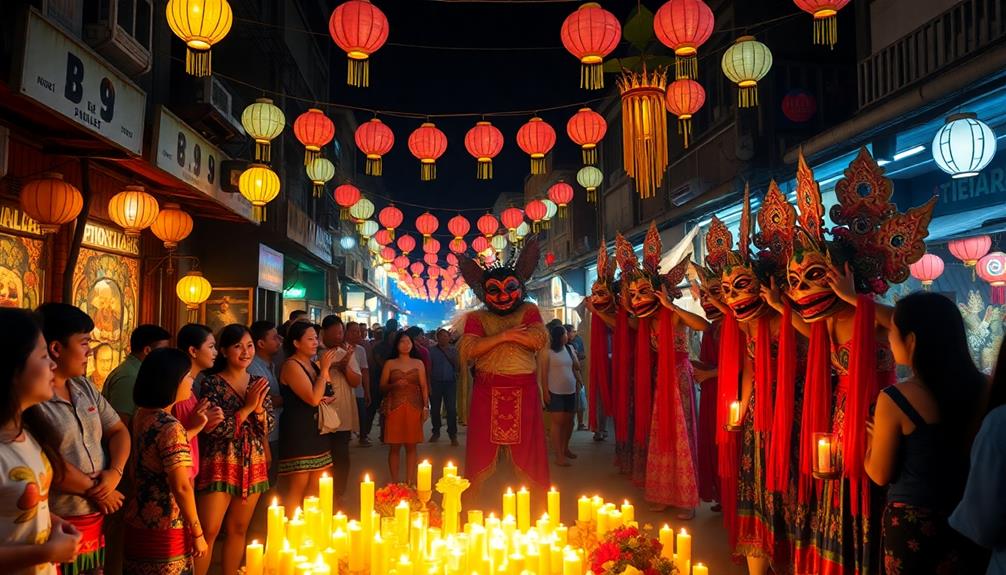
In the Philippines, Pangangaluluwa brings communities together as you honor the spirits of the departed.
You'll see children and adults dressed in costumes, going door-to-door, singing and asking for treats, while the sharing of food and offerings strengthens bonds among neighbors.
This soul-calling ritual not only celebrates the deceased but also fosters a sense of belonging and remembrance within the community.
Traditional Soul-Calling Rituals
The Philippines' vibrant tradition of Pangangaluluwa brings communities together during the Halloween season, blending pre-colonial customs with Catholic beliefs. On the night of October 31, children and young adults commence a joyful journey, going door-to-door to sing carols and ask for food or money. This practice honors the deceased, creating a unique connection between the living and the spirits of their loved ones.
Participants often don costumes, some even dressing as spirits to mimic and pay tribute to their ancestors. This reflects the belief that during this time, the boundary between the living and the dead is blurred, inviting a sense of togetherness.
In rural areas, the ritual may involve lighting candles and offering food at gravesites, fostering a communal atmosphere for remembering loved ones who've passed away. Instead of focusing solely on mourning, Pangangaluluwa showcases a joyful celebration of life and death, allowing families to honor their ancestors' memories.
This blend of traditions highlights the Philippines' rich cultural heritage, reminding everyone that while death is a part of life, it can be celebrated with love and community spirit.
Offerings and Food Shared
As children traverse the streets during Pangangaluluwa, they collect offerings that serve as a bridge between the living and the dead. This Filipino Halloween tradition, celebrated on November 1, sees kids go door-to-door, singing and asking for food to honor the spirits of their deceased loved ones. The belief is that these spirits return to visit their families on All Saints' Day, prompting this heartwarming practice.
As you join in, you'll notice the children carrying lanterns made from coconut shells, illuminating their path as they move from house to house.
The offerings they collect often include:
- Rice cakes
- Candies
- Traditional treats
- Fruits
These food offerings aren't just snacks; they symbolize respect and remembrance for the departed. Each item you give honors the spirits, creating a sense of community as families gather to share stories and meals in their memory.
This unique blend of celebration and remembrance strengthens the bonds between the living and the dead, making Pangangaluluwa a cherished tradition in the Philippines.
Community Involvement and Celebration
Pangangaluluwa isn't just about collecting offerings; it's a vibrant community celebration that brings people together. On the evening of November 1, children and young adults dress in costumes or masks, going door-to-door singing and asking for food or money in exchange for prayers for the dead. This lively tradition combines elements of All Saints' Day with local folklore, deepening your connection to honoring deceased loved ones.
As you participate, you'll notice the warmth of community spirit, with neighbors gathering to share food and stories. It's a time to remember and pray for those who have passed, reinforcing the cultural significance of ancestor worship in Filipino society.
Here's a look at the key aspects of Pangangaluluwa:
| Aspect | Description | Significance |
|---|---|---|
| Costumes | Participants wear masks and festive attire | Adds joy and respect to the occasion |
| Door-to-Door Visits | Singing for offerings | Fosters community connection |
| Food Sharing | Neighbors gather to share meals | Strengthens community bonds |
| Prayers for the Dead | Remembering loved ones | Honors ancestral traditions |
| Cultural Reflection | Celebrates local folklore | Maintains cultural heritage |
Join in this celebration and feel the sense of togetherness that Pangangaluluwa offers!
Día Nacional De La Mascarada – Costa Rica
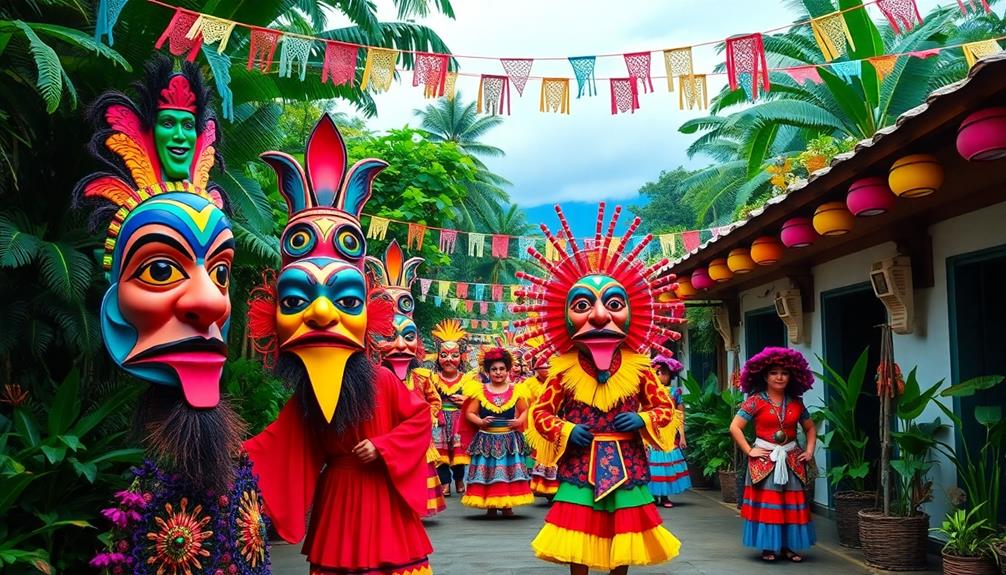
What better way to celebrate Halloween than by immersing yourself in Costa Rica's vibrant Día Nacional De La Mascarada? Held on October 31st, this lively festival showcases an incredible array of masks and costumes that blend traditional and contemporary cultural expressions. As you join the festivities, you'll witness how this event highlights the importance of folklore and artistic creativity.
During the Día Nacional De La Mascarada, you can expect:
- Participants wearing masks that represent historical figures, animals, and mythical creatures
- Colorful parades filled with music and dance that attract both locals and tourists
- Workshops leading up to the festival, where communities come together to create masks
- A celebration that preserves Costa Rican cultural heritage and identity
This festival called Día de los Mascarada has roots in the 19th century and has evolved into a cherished communal celebration.
By taking part in this unique event, you'll not only enjoy the vibrant atmosphere but also appreciate the rich traditions that define Costa Rican identity.
Embrace the joy and creativity that fills the air as you celebrate Halloween in a truly unforgettable way!
Pumpkin Festival – Austria
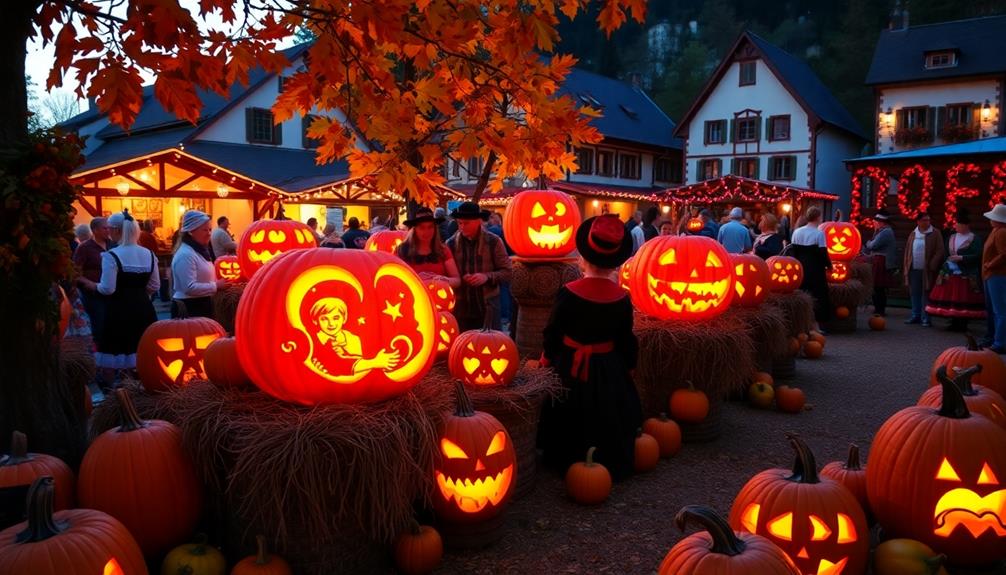
Experience the charm of Austria's Kürbisfest im Retzer Land, a delightful celebration dedicated to all things pumpkin. This pumpkin festival, held annually in late October, showcases a vibrant array of pumpkin-themed activities and dishes that highlight the region's agricultural heritage.
As you wander through the festival, you'll find impressive pumpkin carvings, cooking demonstrations, and fun contests that engage visitors of all ages. The celebration began as a way to honor local farmers and their bountiful harvests.
You can savor delicious pumpkin-based delicacies, from creamy soups to sweet desserts, and even roasted seeds, showcasing the versatility of this seasonal favorite. The festival creates a festive atmosphere as families and friends come together to enjoy the flavors and creativity of pumpkin-inspired cuisine.
Additionally, the event coincides with the Martini celebration on November 11, where local folklore emphasizes leaving bread, water, and a lamp for returning souls. This tradition deepens the connection to the spiritual world, reminding attendees of the importance of honoring ancestral customs.
Embrace the unique blend of fun, food, and tradition at Austria's Kürbisfest, where pumpkins truly take center stage!
Halloween Traditions – Belgium

While Austria celebrates pumpkins in vibrant festivals, Belgium presents a more subdued approach to Halloween. In many areas, you'll find that Halloween isn't universally embraced. Instead, the focus shifts to All Saints Day (La Toussaint) on November 1st, a time dedicated to honoring the dead.
On Halloween night, families light candles in memory of their deceased relatives, reflecting the heartfelt traditions that persist in the country.
Here are some key aspects of Halloween traditions in Belgium:
- Candle Lighting: Families light candles to honor their loved ones who've passed away.
- Regional Variations: Different villages celebrate in unique ways, showcasing local customs.
- Family Gatherings: Traditional foods and family gatherings are common during this time.
- Urban Popularity: In cities, Halloween-themed events are growing, blending local customs with American influences.
Despite the increasing popularity of Halloween, many Belgians still prioritize All Saints Day, emphasizing the importance of remembrance over revelry.
Halloween in Canada
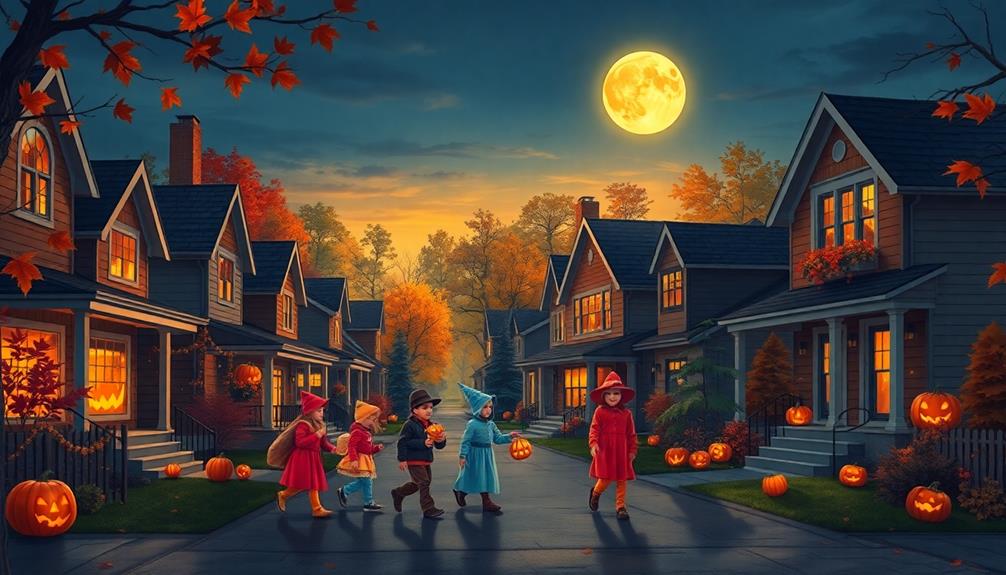
When you think about Halloween in Canada, you can trace its roots back to Scottish and Irish immigrants in the 1800s.
Today, it's all about costume parties, trick-or-treating, and festive activities like pumpkin carving and apple bobbing.
As you explore the modern celebrations, you'll notice a blend of local traditions and American influences shaping the spooky season.
Historical Roots of Halloween
Canada's Halloween traditions trace their origins back to the 1800s, thanks to the influx of Scottish and Irish immigrants who brought their festive customs with them.
These early celebrations laid the historical roots for what you now recognize as Halloween in Canada. With Halloween's growing popularity around the world, Canadian celebrations have also been influenced by Halloween celebrations in Australia, showcasing unique adaptations that reflect local themes.
On October 31, Canadians partake in a blend of customs that reflect both their heritage and the influence of American practices.
You might notice some common activities that have become staples of the celebration, including:
- Trick-or-treating in your neighborhood
- Hosting costume parties with friends and family
- Decorating homes with spooky themes
- Participating in local Halloween events and parades
As the years passed, Halloween's popularity in Canada has skyrocketed, with communities embracing these traditions and showcasing their unique cultural flair.
The influence of Irish immigrants is particularly evident, as they contributed many of the beloved customs you see today. This blend of cultural practices has created a rich tapestry of Halloween celebrations, making October 31 not just a day for candy and costumes, but a time to honor the historical roots that shaped your festive experiences.
Modern Celebrations and Customs
As Halloween approaches, Canadians embrace a vibrant mix of traditions rooted in their diverse cultural heritage. Celebrated on October 31, you'll find communities coming together to enjoy activities like trick-or-treating and costume parties. The holiday, introduced by Scottish and Irish immigrants in the 1800s, has evolved over time, blending various customs into a uniquely Canadian celebration.
Many families also take advantage of local stores with festive decorations and themed products, such as those offered at Ulta Beauty store hours during this season.
In recent years, Halloween's popularity has surged, with Canadians spending an estimated $1 billion annually on decorations, costumes, and candy. You can see this festive spirit reflected in neighborhood decorations and elaborate costumes, showcasing creativity and fun.
Many cities, including Toronto and Vancouver, host street parties and events, bringing people together to celebrate.
Haunted houses and spooky attractions have also become integral to the Halloween experience, providing thrilling entertainment for all ages. Local parades and community events foster a sense of unity, ensuring that everyone can partake in the excitement.
Hungry Ghost Festival – China
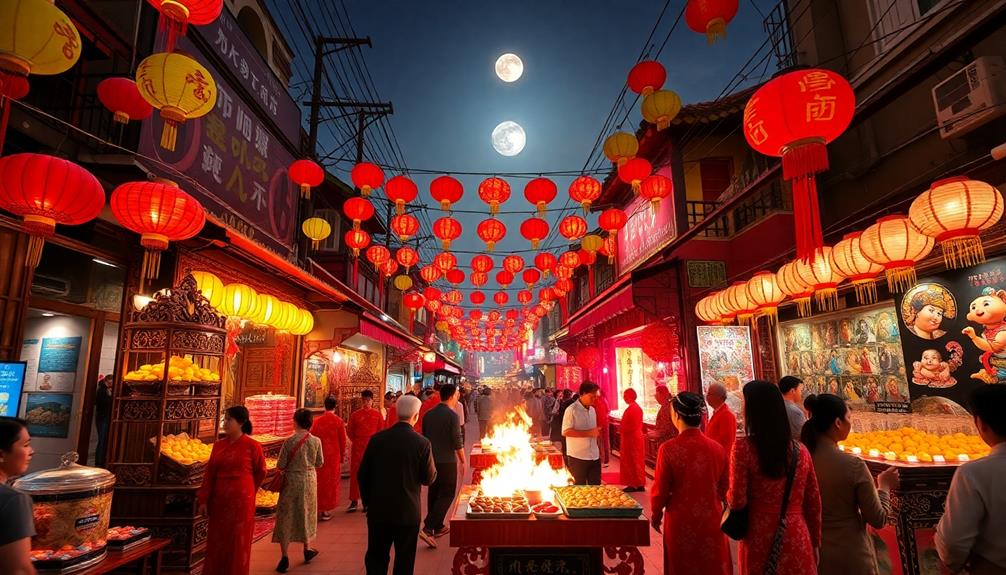
Celebrating the Hungry Ghost Festival in China invites families to honor their deceased ancestors during the seventh lunar month. This special occasion is rooted in the belief that spirits return to the living world, creating a unique opportunity for family members to connect with their past.
During the festival, families engage in several meaningful traditions, including:
- Setting up tables filled with food offerings to welcome the spirits
- Burning incense and joss paper to appease the departed
- Performing lion or dragon dances to ward off evil spirits
- Sharing communal feasts with special dishes symbolizing respect for ancestors
These customs not only show reverence but also strengthen familial bonds, fostering a sense of community and cultural heritage. Families gather to share stories, memories, and meals, reminding everyone of the importance of remembering those who came before them.
The Hungry Ghost Festival serves as a poignant reminder that even in death, the connection between the living and the departed remains strong. By participating, you embrace a rich tradition that honors your ancestors while celebrating the values of family and unity.
Mischief Night – England
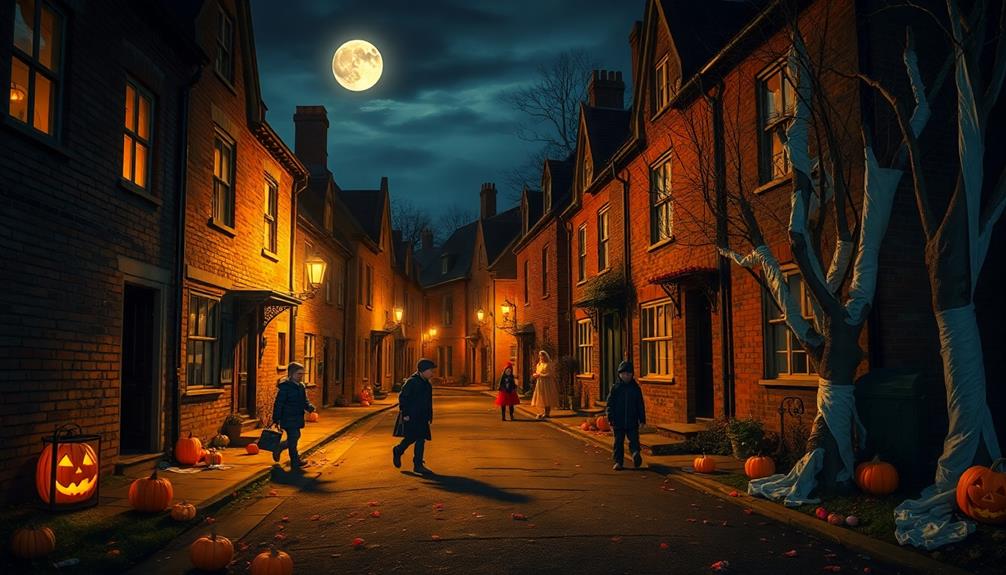
Mischief Night, observed in England on October 30th, is filled with playful pranks and spirited antics that set the tone for Halloween. You'll see children knocking on doors, not just for treats but to engage in lighthearted mischief. It's a night when harmless vandalism rules, with kids soaping windows, ringing doorbells, and dashing away before anyone catches them.
Traditionally, children would carve intricate designs into large beets known as "punkies," carrying them around as they ask for goodies. This custom adds to the festive spirit, showcasing creativity and fun. In some areas, kids also ask for "a penny for the Guy," referencing a Guy Fawkes effigy, which ties the night to broader British cultural celebrations.
Mischief Night has seen a resurgence in popularity among younger generations, blending seamlessly with American Halloween traditions. This playful night encourages camaraderie among neighbors and brings a sense of community, as laughter and light-hearted pranks echo through the streets.
Commercialized Halloween – Hong Kong

In recent years, Halloween has exploded in popularity across Hong Kong, especially in bustling urban areas filled with expats. This commercialized Halloween has transformed the way people celebrate, creating a vibrant atmosphere that combines Western customs with local flair.
Major theme parks like Disneyland and Ocean Park take center stage, hosting elaborate events that attract both locals and tourists. During this time, many restaurants and cafes extend their hours, offering themed menus and special treats for those looking to celebrate with spooky delights, reflecting the local business operating times.
During this time, you can expect:
- Haunted houses and spooky performances in theme parks
- Shopping centers decked out with eerie decorations
- Costume contests showcasing creativity and fun
- Themed parties blending traditional Halloween with local culture
The extensive decorations in shopping malls draw huge crowds, while costume contests and themed parties reveal a unique Halloween spirit.
This festive season has become a canvas where traditional customs are reimagined, resulting in an experience that's both familiar and fresh. Whether you're wandering through a haunted maze or enjoying a themed cocktail, Hong Kong's Halloween offers a dynamic mix that keeps you coming back for more.
Embrace this unique Halloween and enjoy the excitement it brings!
Original Halloween – Ireland
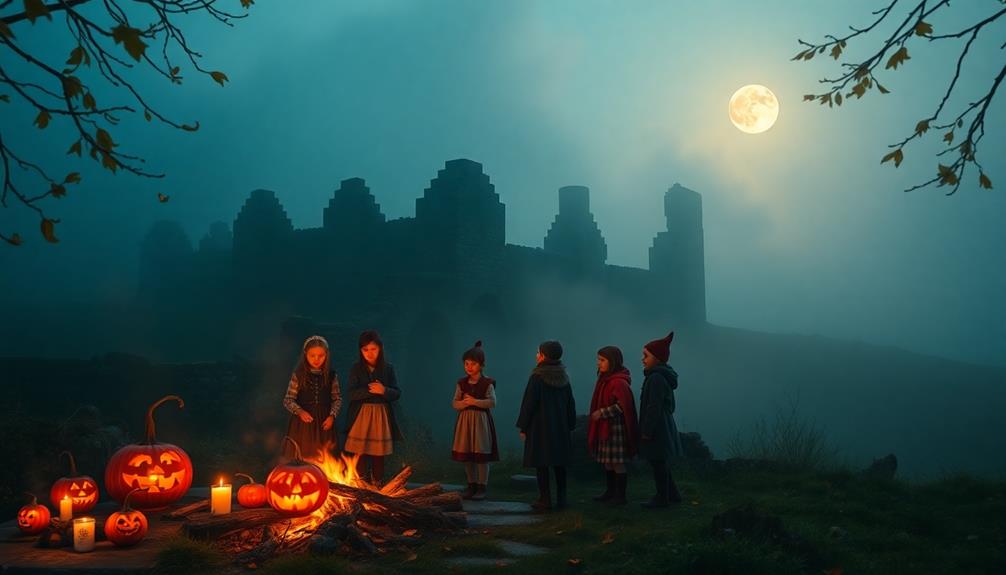
Halloween traces its roots back to Ireland, where the ancient Gaelic festival of Samhain marked the shift from harvest to winter. On the evening of October 31, people believed the boundary between the living and the dead blurred, allowing spirits to roam the earth. To ward off these ghosts, they lit bonfires and donned costumes.
Here's a glimpse of some original Halloween customs from Ireland:
| Custom | Description |
|---|---|
| Fortune-Telling Games | People played games to predict their future. |
| Barnbrack | A fruitcake with hidden objects, each symbolizing different fortunes. |
| Modern Adaptations | Today, traditions like trick-or-treating and pumpkin carving have evolved from these ancient practices. |
Festivities in Ireland today blend these historical customs with modern celebrations, seen in events like the Puca Festival and Derry Halloween. These occasions showcase the rich history of the original Halloween while embracing contemporary fun. So, when you celebrate Halloween, remember its Irish origins and the unique traditions that continue to thrive today.
Chuseok – Korea
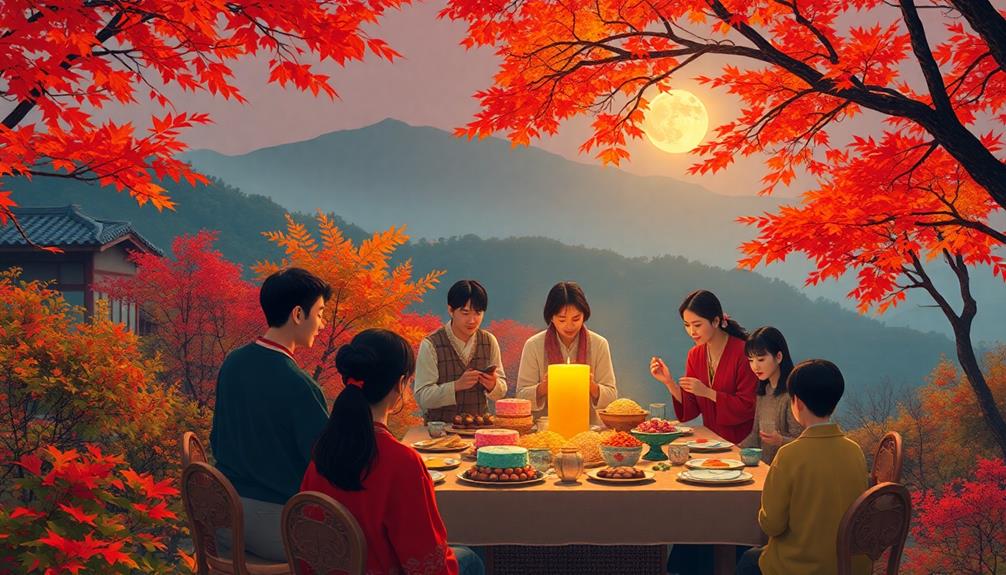
Chuseok, often referred to as Korea's Harvest Festival, is a vibrant celebration that takes place in late September or early October.
It's a time for families to come together, honoring their ancestors and celebrating life. During this festive period, you'll find families gathering to perform rituals known as Charye. They prepare a table filled with food offerings to pay their respects.
Here are some highlights of Chuseok:
- Traditional Foods: Enjoy delicious dishes, especially songpyeon, a rice cake filled with sweetened sesame seeds.
- Family Reunions: Many people travel back to their hometowns, creating a busy but joyful atmosphere.
- Cultural Activities: Engage in folk games and dances that reflect Korea's rich heritage.
- Hanbok Attire: Witness the beauty of traditional Korean clothing, as families often wear hanbok during these festivities.
Chuseok isn't just about honoring the past; it's also a time to celebrate the present with loved ones.
The holiday beautifully blends remembrance and joy, making it a cherished occasion for everyone involved.
Frequently Asked Questions
What Unique Traditions Does Your Country Have for Halloween?
In your country, you might celebrate Halloween with special foods, games, or rituals. Families could gather for unique treats, while children often dress up, sharing laughter and excitement, creating memorable traditions that bring everyone together.
Is Halloween Celebrated Differently Around the World?
You'll find Halloween's spirit dances differently across the globe. Some honor loved ones with vibrant altars, while others revel in costume parades, creating a tapestry of traditions that celebrate life, memory, and community in unique ways.
What Unique Traditions Does Europe Have for Halloween?
Europe's Halloween traditions are diverse. You'll find bonfires in Ireland, playful pranks in Scotland, cemetery visits in Italy, welcoming spirits in Austria, and Dracula-themed festivities in Romania, all adding unique flavors to the celebration.
What Is the Biggest Halloween Tradition?
Did you know that over 175 million Americans participate in Halloween festivities? The biggest tradition is trick-or-treating, where kids dress up and collect candy, a fun practice that brings neighborhoods together each October 31st.
Conclusion
As you embrace the enchanting tapestry of Halloween traditions worldwide, remember that these celebrations bring people together in joyful remembrance and playful spirit. Whether you're honoring ancestors in Mexico or delighting in mischievous antics in England, each custom adds a unique flavor to the season. So, as you carve your pumpkins and don your costumes, let the warmth of these diverse cultures inspire your festivities. After all, it's all about creating cherished memories that linger long after the last ghost has vanished!


